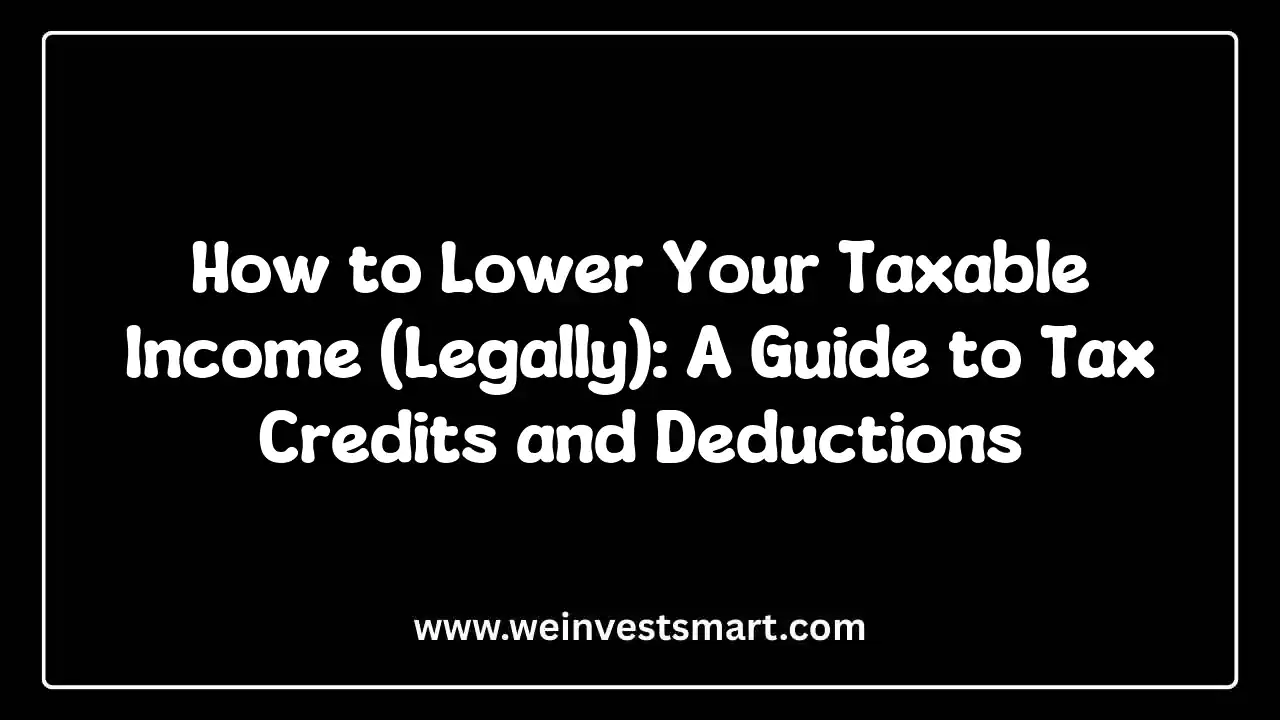· WeInvestSmart Team · personal-finance · 9 min read
Marginal vs. Effective Tax Rate: The Difference and Why It Matters
Clarify a common point of confusion. We explain that your marginal rate is the tax on your next dollar earned, while your effective rate is the average tax you actually pay on all your income.
Most people fundamentally misunderstand how their income is taxed, and this misunderstanding costs them dearly. They hear the phrase “24% tax bracket” and assume their entire income is being taxed at nearly a quarter. But here’s the uncomfortable truth: that single number is a deeply misleading and financially paralyzing piece of information. Going straight to the point, if you don’t know the difference between your marginal tax rate and your effective tax rate, you are navigating your financial life with a broken compass.
We’ve all heard the cautionary tales, often whispered around the office: “Don’t take that overtime, it’ll just push you into a higher tax bracket and you’ll end up losing money.” This sentiment is so common, so widely believed, that it has crippled the financial growth of millions. It stems from a complete misreading of how the U.S. tax system is designed. It’s a system built on a progressive, tiered structure, not a flat, punitive one.
What if we told you that the tax rate you see in the headlines is almost certainly not the rate you’re actually paying? And what if understanding the real rate could fundamentally change how you approach raises, side hustles, and investments? Here’s where things get interesting. Your tax return contains two critical, but very different, numbers. One tells you the tax on your next dollar earned, and the other tells you the tax you paid on all your dollars. And this is just a very long way of saying that learning to distinguish between the two is like switching from blurry analog to high-definition digital in your financial planning.
How Your Income Is Really Taxed: The Bucket Analogy
Before we define the terms, we must first destroy the biggest myth in personal finance: the “bracket myth.” The U.S. has a progressive tax system, which means higher levels of income are taxed at progressively higher rates. But the key insight most people miss is that those higher rates only apply to the income within that specific bracket.
Think of your income as water and the tax brackets as a series of buckets, each one bigger than the last and with a different tax rate painted on the side.
- Bucket 1 (10%): You pour your first dollars of taxable income into this bucket. Everything in this bucket is taxed at 10%.
- Bucket 2 (12%): Once the first bucket is full, the overflow spills into the second bucket. Every dollar that lands in this bucket is taxed at 12%.
- Bucket 3 (22%): And so on.
The funny thing is, getting a raise that pushes you into a higher bracket doesn’t change the tax rate on the money in the lower buckets. It just means the new money—the overflow—starts filling a bucket with a higher tax rate. You never, ever take home less money by earning more.
You may also be interested in: How Your Credit Score Actually Works: A Beginner’s Guide to Building and Protecting It
What Is a Marginal Tax Rate? The Rate on Your Next Dollar
Now we can get to the definitions. Your marginal tax rate is the tax rate you will pay on the very next dollar you earn. It is the rate associated with the highest tax bucket (bracket) your income has reached. This is the number that should guide your short-term financial decisions, because it tells you the immediate tax consequence of any new income.
Let’s use a concrete example. Here are the simplified 2025 federal tax brackets for a single filer:
| Tax Rate | Taxable Income (Single Filer) |
|---|---|
| 10% | $0 to $11,925 |
| 12% | $11,926 to $48,475 |
| 22% | $48,476 to $103,350 |
| 24% | $103,351 to $197,300 |
| 32% | $197,301 to $250,525 |
| 35% | $250,526 to $626,350 |
| 37% | Over $626,350 |
Imagine a software engineer named Alex, who is a single filer with a taxable income of $100,000. Looking at the chart, Alex’s income fills the 10% and 12% buckets and spills into the 22% bucket. Because his last dollar earned is in the 22% bracket, his marginal tax rate is 22%. If Alex is offered a $5,000 bonus, he can accurately estimate that he will pay approximately $1,100 in federal tax on it (22% of $5,000), taking home $3,900.
You may also be interested in: The Art of the “Sinking Fund”: How to Save for Big, Predictable Expenses
What Is an Effective Tax Rate? Your Actual Average Rate
This is where the picture gets much clearer. Your effective tax rate is the blended average rate of tax you pay on your entire income. It represents the true, overall percentage of your income that goes to the IRS. To calculate it, you simply take your total tax bill and divide it by your total taxable income.
Let’s go back to Alex and his $100,000 income. How much tax does he actually pay?
- 10% on the first $11,925 = $1,192.50
- 12% on the income from $11,926 to $48,475 ($36,549) = $4,385.88
- 22% on the income from $48,476 to $100,000 ($51,524) = $11,335.28
Alex’s total federal tax bill is $1,192.50 + $4,385.88 + $11,335.28 = $16,913.66.
To find his effective tax rate, we divide his total tax by his total taxable income: $16,913.66 / $100,000 = 0.1691, or 16.91%.
Here’s where things get interesting: even though Alex is in the 22% marginal tax bracket, his actual, overall tax burden is only 16.91%. That is a massive difference in perception and reality. He isn’t paying 22% on everything; he’s paying a blended rate that is significantly lower.
You may also be interested in: Taxes for Newbies: Understanding Your Paycheck Stub and Basic Tax Deductions
Why This Distinction Is a Financial Game-Changer
This isn’t just a fun piece of tax trivia; it’s a critical tool for strategic financial planning. Using the wrong rate for the wrong decision can lead to costly errors.
1. Evaluating a Raise or Side Hustle
When deciding whether to take on a side project or push for a raise, your marginal tax rate is the only number that matters. It tells you exactly how much of that new income you’ll actually get to keep after federal taxes. It allows you to make an informed decision about whether the after-tax reward is worth the extra effort.
2. Understanding the Power of Tax Deductions
This sounds like a trade-off, but it’s actually one of the most powerful insights. The value of a tax deduction is determined by your marginal tax rate. A tax deduction works by reducing your taxable income from the top down. That is to say, it removes dollars from your highest-taxed bucket. If Alex contributes $1,000 to a traditional IRA, he doesn’t save 16.91% on that money; he saves 22%, because he’s removing $1,000 from the 22% bucket. His deduction is worth $220, not $169. This understanding turns tax-deductible savings accounts (like a 401(k), traditional IRA, or HSA) into supercharged investment vehicles.
3. Making Smart Budgeting and Long-Term Plans
While the marginal rate is for decision-making at the edges, your effective tax rate is perfect for the big picture. It gives you the most accurate measure of your total tax burden, which is essential for creating a realistic annual budget. When you’re planning years ahead for retirement or other major goals, using your effective tax rate provides a much more realistic projection of your after-tax income and savings potential.
You may also be interested in: Rent vs. Buy: The Real Math Behind the Biggest Financial Decision of Your Life
The Bottom Line: This Is More Than Just Two Numbers
The distinction between marginal and effective tax rates is the difference between being a passive financial passenger and an active, strategic driver. The fear of “moving up a tax bracket” is a phantom that vanishes with understanding, replaced by the clarity of a tiered system designed to be fair. Knowing your marginal rate empowers you to make precise, informed decisions about new opportunities, while knowing your effective rate gives you a stable, holistic view of your financial health.
And this is just a very long way of saying that financial literacy is about knowing which tool to use for which job. The marginal rate is your scalpel for surgical financial decisions. The effective rate is your compass for long-term navigation. You get the gist: master both, and you will forever transform how you see your money, your taxes, and your path to building wealth.
This article is for educational purposes only and should not be considered personalized tax advice. Tax laws are complex and change frequently. Consider consulting with a qualified tax professional for guidance specific to your situation.
Marginal vs. Effective Tax Rate FAQ
What is a marginal tax rate?
Your marginal tax rate is the tax rate you pay on your next dollar of earned income. In the U.S. progressive tax system, it’s the rate for the highest tax bracket your income falls into. It’s the most important rate for evaluating the tax impact of a raise or additional income.
What is an effective tax rate?
Your effective tax rate is the average tax rate you pay on your entire taxable income. It’s calculated by dividing your total tax liability by your total taxable income. This rate gives you the truest picture of your overall tax burden for the year.
Which rate is higher, marginal or effective?
For almost everyone, the marginal tax rate is higher than the effective tax rate. This is because only a portion of your income is taxed at your highest marginal rate, while the rest is taxed at lower rates, bringing your overall average (effective) rate down.
If I get a raise and move into a higher tax bracket, will all my income be taxed at the higher rate?
No, this is a common myth. In a progressive tax system, only the income that falls into the new, higher bracket is taxed at that higher rate. All of your income up to that bracket’s threshold is still taxed at the same lower rates as before.
Why does understanding the difference matter?
Understanding the difference is crucial for smart financial decisions. Your marginal rate tells you the immediate tax impact of earning more money and the true value of a tax deduction. Your effective rate is best for understanding your overall tax burden and for long-term financial planning and budgeting.



